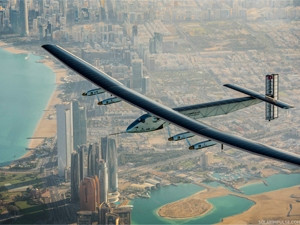
The Solar Impulse 2 (Si2) took off this morning from Abu Dhabi, on the first attempt at a round-the-world solar-powered trip. Swiss pilots Bertrand Piccard and Andr'e Borschberg will take turns flying the plane, which can stay in the air for up to six days and nights in a row.
"With our attempt to complete the first solar-powered round-the-world flight, we want to demonstrate clean technology and renewable energy can achieve the impossible. Renewable energy can become an integral part of our lives, and together, we can help save our planet's natural resources," said Piccard, who is also Solar Impulse chairman and the first balloonist to circumnavigate the globe.
The trip will take about 25 flight days, spread out over five months, covering 35 000km and travelling at speeds of between 50 and 100km/h. The plane will stop in Oman, India and China, before crossing the Pacific Ocean via Hawaii.
The Si2 will then fly across North America, stopping in three locations, and then cross the Atlantic. The final leg includes a stop-over in Southern Europe or North Africa before arriving back in Abu Dhabi by late July or early August, depending on weather conditions.
"Solar Impulse is not the first solar airplane; however, it is the first able to cross oceans and continents - remaining in the air for several days and nights in a row without landing," said Borschberg, also Solar Impulse co-founder and CEO.
"But now we have to ensure the sustainability of the pilot in order to complete the route; [the] Si2 must accomplish what no other plane in the history of aviation has achieved: flying without fuel for five consecutive days and nights with only one pilot in the unpressurised cockpit."
Piccard and Borschberg will live in the tiny Si2 single-seater cockpit with enough food and oxygen for a week. The wingspan of the Si2 is bigger than that of a Boeing 747, but only weighs the equivalent of a small car.
In 2013, Piccard and Borschberg successfully completed a solar-powered journey across the US, but encountered problems with a tear on the left wing, which forced them to land three hours ahead of schedule.
Share